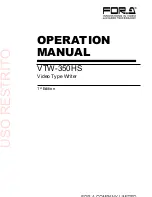
Software Overview
23
Interfacing the TLV1562 Parallel ADC to the TMS320C54x DSP
8.3.9
Enabling Software Modules (.if/.elseif/.endif)
To test different software solutions while keeping the number of files small
requires integrating all the modules in the same file. Furthermore, a switch is
needed to enable any of the software modules. Setting the constant SWITCH in
the program header to either one or zero enables/disables the instructions inside
an .IF-.ENDIF loop. Example:
SWITCH1
.set
00001h
SWITCH2
.set
00000h
...
.if SWITCH1
instruction_X
; the instructions on this line will be assembled
.elseif SWITCH2
instruction_Y
; the instructions on this line will be ignored
.endif
In this example, instruction_X is executed (linked into object code) while
instruction_Y is ignored. Setting SWITCH2 instead of SWITCH1 to 1 enables
instruction_Y and makes the compiler link it to object code. If both switches are
one, only instruction_X is compiled.
8.4
Software Code Explanation
The next capture describes the software solution to interface the TLV1562 and
the two DACs on the EVM board. Although the code looks very large and
complicated at first, it is a simple solution with only a little knowledge of the code
required to verify/customize the settings. The TLV1562 (ADC) offers a wide
choice of settings. First, choose the conversation mode. This application report
provides one file for each mode. Many settings (2s complement, channels, etc.)
must be selected. This software allows a variation of those parameters in the
program header. A simple switch enables or disables each component. After
recompiling the code with a special setting of all switches, the code becomes
much smaller and easier to understand. The .if/.elsif/.endif instruction allows the
program to use or ignore blocks of instruction between the statements.
If, for example, one does not want to use the serial DAC and disables the switch
SEND_OUT_SERIAL, all the source code for the serial conversation between
DSP and DAC is ignored. The compiler will not implement any code related to the
serial DAC.
8.4.1
Software Principals of the Interface
Controlling the status of signals can be done in different ways. One of the
challenges in this interface is controlling signal status when the ADC conversion
is finished and the digital result is ready to be transferred from the ADC to DSP.
A high/low transition on the INT line of the TLV1562 informs the DSP that the ADC
has completed the conversion. Optionally, the DSP can ignore the INT signal,
initialize the conversion instead, wait for a defined time, and directly read the
result out of the ADC. This solution requires knowing the precise time for
conversion/data ready on the bus for each converter/mode.
Three options are given for each mode to match different custom needs; they are
listed in the next three sections.
Содержание TLV1562
Страница 6: ...vi SLAA040 ...
















































